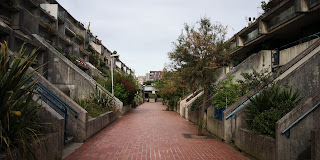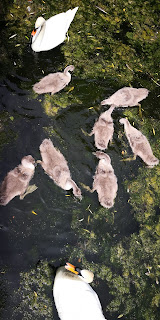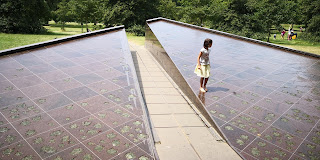It might've been better if I'd gotten Emmy the Great to host my second Brutalist London walk. It's not that it was a bad day, far from it, but more that it wasn't particularly brutal. With four parks crossed, waterfowl a plenty, gorgeous sunshine, and laughs galore it certainly wasn't the grey concrete nightmare scenario that those of a cynical nature may've imagined.
As ever, we met at noon in Waterloo station, on the mezzanine, in Benugo, by the big clock. There was a 'good turnout' (if not a record beating one). Myself, Shep, Adam, Pam, Neil, Belinda, Sanda, and Dena started the walk and we were later joined by Colin, fashionably late, who'd come down from Oxford.
The idea was to finish off the walk we failed to complete back in February but as there were only two buildings left to see on that walk I added a couple more in and because it was happening on a sunny day I rerouted the walk to take in plenty of green spaces. I wrongfooted my fellow walkers by taking a left down Belvedere Road and then through Jubilee Gardens where we joined the heaving tourist hordes waiting to go on the London Eye.
There was a monument to the International Brigade that fought in the Spanish Civil War that I'd never noticed before despite an inscription on it saying it was unveiled by Michael Foot back in 1985. We crossed Westminster Bridge, a sea of human traffic, identified Boudicca in Thomas Thornycroft's Boadicea and Her Daughters statue, and crossed in the shadow of the Houses of Parliament (Elizabeth Tower covered in scaffolding) to Parliament Square and its statues of Winston Churchill, David Lloyd George, Gandhi, Jan Smuts, Nelson Mandela, and, of course, the recently unveiled one of campaigner for women's suffrage Millicent Fawcett, sculpted by Gillian Wearing after Caroline Criado Perez's admirable campaign.
The March for a People's Vote was due to arrive in Parliament Square in an hour or so and many EU flags were already being flown in anticipation. Bearing in mind the likely disasters of Brexit and the government's utterly woeful handling of said Brexit it was a march I very much supported. One I may have attended if I had not been so fully dedicated to London by Foot:The Capital's Curious Circuits.
We passed a Volvo, of course a Volvo, literally plastered in anti-Brexit slogans and the baroque grandeur of the Methodist Central Hall while we looked across to the huge queues of people waiting to go into Westminster Abbey. But there would be not a soul lining up to see 102 Petty France, our first brutalist icon.
102 Petty France was designed by Basil Spence (whose house, very much not a brutalist building, I happened across in Canonbury on Friday) who is most famous for rebuilding Coventry Cathedral after it was bombed in World War II. Completed in 1976 it certainly would've stood out among the Georgian town houses of the area and not all were happy about its erection. Norman St John-Stevas, later Lord Fawsley and a former Tory Minister of State for the Arts, complained that not only did Spence ruin one of London's finest parks, nearby St James's Park, but two. We shall see what he 'did' to Hyde Park soon.
102 Petty France now houses the Ministry of Justice but until 2004 was the HQ of the Home Office. It stands very close to Charles Holden's 55 Broadway which we took in as part of our Art Deco walk last summer. As with that walk we next turned down Queen Anne's Gate and crossed Birdcage Walk into St James's Park. It was a beautiful day and the park was full of sunbathers and people sucking on cold beers and even colder ice creams. We saw pelicans, coots, swans with their baby cygnets, and geese. It would not be our last experience of waterfowl on our walk.
We crossed the park and reached The Mall which we followed until we reached Buckingham Palace. It's a strange part of London which sees so many tourists but very few actual Londoners. A child played in the waters of the Canadian war memorial in Green Park and we walked on a path parallel to Constitution Hill until we reached further war memorials in and around Hyde Park Corner and Duke of Wellington Place.
The Wellington Arch was built by the fantastically named Decimus Burton, who had a hand in London Zoo and much of the design of Tunbridge Wells, to celebrate British victories in the Napoleonic Wars. Nearby Aspley House (or No 1 London if you prefer) is a neo-classical pile built by Robert Adam (also responsible for the much lovelier Pulteney Bridge in Bath) for the Duke of Wellington to use as his townhouse. His place out in the country is much bigger. It's now a gallery and, this is remarkable, one I've never been in.
Once we'd entered Hyde Park we ambled steadily along the broad sand covered Rotten Row (named as Route du Roi, the route of kings, but bastardised by the English who've never been great with languages). It was built so William III could ride from Kensington Palace to St.James's Palace unhindered and, possibly due to the preponderance of highwaymen and footpads (much like Hounslow Heath), it became the first artificially lit highway in Britain. It used to be a fashionable place to ride posh nags but today's roller bladers and skateboarders prefer the smoother paths that run alongside Rotten Row.
In the Serpentine, standing proud above the leisure boats and pedalos, is Christo's new sculptural installation. A near pyramid, or mastaba, of barrels. I'll be going back for a proper look at it, and possibly be writing another blog about it, very soon but for now we just enjoyed the spectacle.
Through the trees the tower of Hyde Park Barracks poked out. A tower built, like 102 Petty France, by Basil Spence - and the one that St John-Stevas got snotty about. He wasn't the only one. AA Gill called it the ugliest building in Britain and Country Life magazine rated it number eight on a list of Britain's top ten eyesores! Attempts to list it have, perhaps unsurprisingly, so far been rejected but a quick vox pop among the walkers decreed that none of us were offended by it. Certainly the geese and fluffy goslings that stood in front of us admiring it didn't seem offended. They'd probably be more offended at being eaten by AA Gill. He seemed like the sort of man who ate geese.
Near the surprisingly lovely Princess Diana memorial (it's not a statue, but a water park that's very popular with kids) stood a statue of a heron. But on Serpentine Bridge itself stood an actual heron. Herons are always an impressive sight and this one, like many others observed recently, seemed to be posing for the benefit of the humans passing by.
Passing under the bridge took us from Hyde Park to Kensington Gardens (our fourth royal park of the day, there are eight in total - the others being Bushy, Richmond, Greenwich, and Regent's) and here the Serpentine becomes the Long Water and eventually meets the Italian Gardens.
Parakeets are normally in abundance along this stretch but there weren't many on show during our visit. Instead a Rolls Royce dispensed ice creams, people relaxed in deck chairs, fountains sprayed water into the clear blue sky creating wonderful patterns, and the whole scene really spoke of what is best about London, best about life. All that was missing was a pub.
But not for long. That train's never late. The Swan sits on the edge of the park and if all the outdoor seats were taken it didn't matter too much. We'd be spending plenty of the day out in the sun. We pulled a couple of tables up, some had chips, I took a pint of Mahou (and then a second one), and we had a nice chat as Belgium pummeled Tunisia 5-2 in the World Cup on a distant tv screen. The toilets of the pub contained an advert for a Gong and Kevin Coyne gig that finished at 3pm!
Soon we were back on our feet for the final stretch. Bishop's Bridge Road took us past Paddington station and down to the canal. Barges done up as bars, mid range chain eateries, and cyclicts all jostled for space in a good natured fashion as we made our way towards Little Venice.
Little Venice is decidedly not an area big on brutalism. Regency stucco mansions are the order of the day here and blue plaques on the Colonnade Hotel testify to it once being home to both Alan Turing and Sigmund Freud. We followed the canal past tower blocks being stripped of their cladding in the wake of the Grenfell disaster (we weren't actually far from the blackened shell of that tower block but we couldn't see it, maybe for the best) as the area went a tad more down at heel.
Still pleasant though as people sat in canalside parks or dozed on benches. Egyptian geese and goslings were still at play. Soon we reached the Trellick Tower, surely an absolute must on anyone's list of brutalist icons to see in London.
The summer breeze was making me feel fine (blowing through the jasmine of my mind) as we looked up to Erno Goldfinger's masterpiece, disappointingly wrapped in blue material and scaffolding. Ian Fleming was no fan of Goldfinger and even went so far as to name one of James Bond's chief antagonists after him. Erno Goldfinger, not Auric, was born in Budapest in 1902, a Jew who moved to Paris at the age of 21 after the fall of the Austro-Hungarian Empire. In Paris he fell under the influence of Le Corbusier but from the thirties onwards he spent the rest of his career in the UK after falling in love with and marrying Ursula Blackwell (heir to the Crosse & Blackwell fortune).
While Ursula was bringing out the Branston, Goldfinger was ploughing a lonely furrow by sticking with brutalism and high rises long after they'd fallen out of fashion. Trellick soon became a magnet for crime, vandalism, drugs, and prostitution but in the eighties (possibly, as Colin (resolutely not a Tory) suggested, due to Thatcher's right to buy scheme) things started improving in the tower. As they do to this day. It's now so iconic it features on mugs and was used as an ident for the London Olympics in 2012. Blur, The Verve, and, less impressively, Hard Fi used it in music videos and it featured in London Fields by Martin Amis and is said to be a key inspiration for JG Ballard's High Rise. It's now Grade II listed.
From Trellick we crossed the canal, wandered down Harrow Road and through Maida Vale until we finally reached Kilburn. This was to be our last stop and, according to Adam, I'd saved the best for last.
The Alexandra Road Estate, just off Abbey Road (but no time for any Beatles based shenanigans), was designed by Neave Brown in 1968 and completed ten years later. Brown was born in New York state in 1929 and died in January of this year. Built in the form of an ancient Mesopotamian ziggurat with the roads and parking space hidden beneath pedestrianised walkways it's a joy to walk round but is it a joy to live in?
That's impossible to know but it certainly seems to have been a new, interesting, and less imposing way to do brutalism. From the outside the back of the building may look like a giant football stadium such as the San Siro in Milan but once in the complex it's a much softer affair, helped no doubt by the copious greenery that flanks the walkways and brightens up the concrete and glass facades.
It's been used in The Sweeney, Spooks, Prime Suspect, and 28 Weeks Later and pop videos have been filmed there by Richard and Linda Thompson, Foals, The 1975, J Hus, and Kirsty MacColl. Neave Brown also built the similar Dunboyne Road Estate in Gospel Oak but we were done walking for the day and retired to the nearby Priory Tavern to raise a pint or two in memory of Neave. Colin had a 'bake' which turned out to be over priced soup so we moved on to The Old Bell for more beer, more gin, more chips, and some veggie bangers'n'mash. It was lovely to sit in the garden with good friends and feel satisfied that I'd managed to organise and execute such a splendid day out.
Thanks to Pam and Bee (for providing photos for this blog) and thanks to them, Sanda, Shep, Adam, Colin, Dena, and Neil for joining us. I'd walk these walks on my own (and I have done) but they'd be nowhere near as much fun without such great company to share the day with. On September 15th London by Foot:The Capital's Curious Circuits will be hosting Werewolves of London:A musical tour of a Strange Town and it'd be my absolute pleasure if you were to join us.



















































































1. There was a good play on Radio 4 Extra last week about the opposition to the building of Goldfinger's home on the edge of Hampstead Heath - now a National Trust property.
ReplyDelete2. The Duke of Wellington still has a flat on the top floor of Apsley House. I believe he still owns the property, as he got rid of the V&A (who once ran the Wellington Museum) in favour of Historic England after a row about the V&A's use of the Museum for evening receptions.
Great info (which I've only just spotted), 'Unknown'!
ReplyDeleteExcellent! Wish I'd be on this one.
ReplyDelete